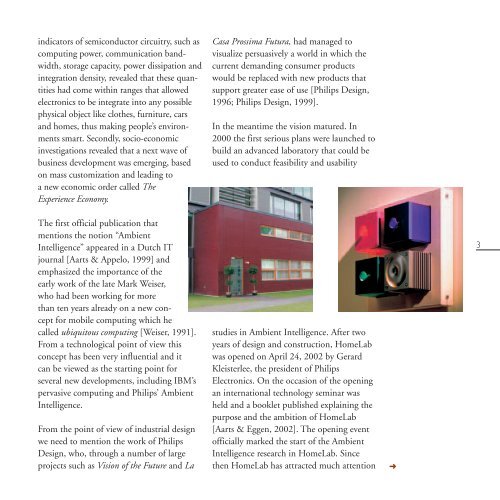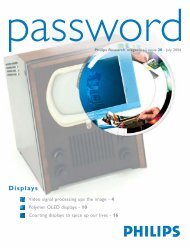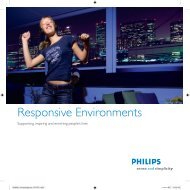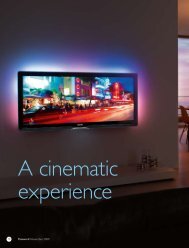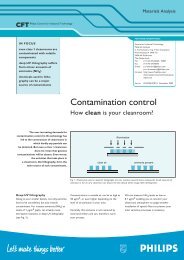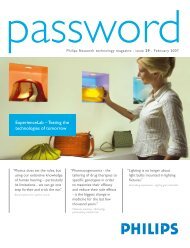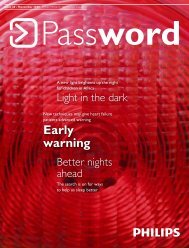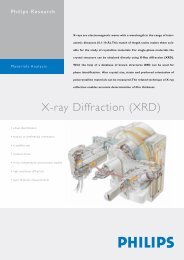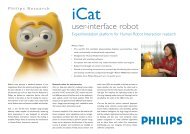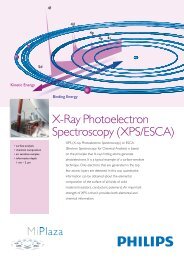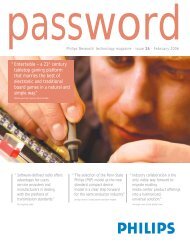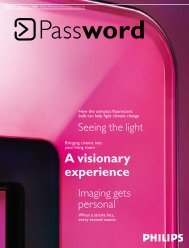365 DAYS AMBIENT INTELLIGENCE IN HOMELAB - Philips Research
365 DAYS AMBIENT INTELLIGENCE IN HOMELAB - Philips Research
365 DAYS AMBIENT INTELLIGENCE IN HOMELAB - Philips Research
You also want an ePaper? Increase the reach of your titles
YUMPU automatically turns print PDFs into web optimized ePapers that Google loves.
Ambient 05-05-2003 12:35 Pagina 3<br />
indicators of semiconductor circuitry, such as<br />
computing power, communication bandwidth,<br />
storage capacity, power dissipation and<br />
integration density, revealed that these quantities<br />
had come within ranges that allowed<br />
electronics to be integrate into any possible<br />
physical object like clothes, furniture, cars<br />
and homes, thus making people’s environments<br />
smart. Secondly, socio-economic<br />
investigations revealed that a next wave of<br />
business development was emerging, based<br />
on mass customization and leading to<br />
a new economic order called The<br />
Experience Economy.<br />
Casa Prossima Futura, had managed to<br />
visualize persuasively a world in which the<br />
current demanding consumer products<br />
would be replaced with new products that<br />
support greater ease of use [<strong>Philips</strong> Design,<br />
1996; <strong>Philips</strong> Design, 1999].<br />
In the meantime the vision matured. In<br />
2000 the first serious plans were launched to<br />
build an advanced laboratory that could be<br />
used to conduct feasibility and usability<br />
The first official publication that<br />
mentions the notion “Ambient<br />
Intelligence” appeared in a Dutch IT<br />
journal [Aarts & Appelo, 1999] and<br />
emphasized the importance of the<br />
early work of the late Mark Weiser,<br />
who had been working for more<br />
than ten years already on a new concept<br />
for mobile computing which he<br />
called ubiquitous computing [Weiser, 1991].<br />
From a technological point of view this<br />
concept has been very influential and it<br />
can be viewed as the starting point for<br />
several new developments, including IBM’s<br />
pervasive computing and <strong>Philips</strong>’ Ambient<br />
Intelligence.<br />
From the point of view of industrial design<br />
we need to mention the work of <strong>Philips</strong><br />
Design, who, through a number of large<br />
projects such as Vision of the Future and La<br />
studies in Ambient Intelligence. After two<br />
years of design and construction, HomeLab<br />
was opened on April 24, 2002 by Gerard<br />
Kleisterlee, the president of <strong>Philips</strong><br />
Electronics. On the occasion of the opening<br />
an international technology seminar was<br />
held and a booklet published explaining the<br />
purpose and the ambition of HomeLab<br />
[Aarts & Eggen, 2002]. The opening event<br />
officially marked the start of the Ambient<br />
Intelligence research in HomeLab. Since<br />
then HomeLab has attracted much attention<br />
➜<br />
3


